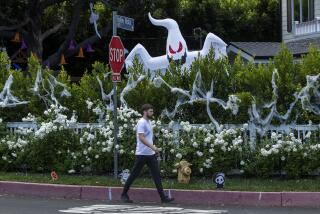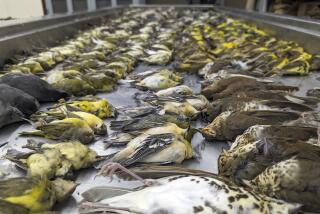Bright Electric Insulators Lure Hummingbirds to Their Deaths
- Share via
The electrocution of hummingbirds that mistake brightly colored fence insulators for flowers is thinning out rural populations of the birds, and wildlife experts are trying to get farmers to switch to more somber-colored fences.
Hummingbirds’ fondness for bright red, orange and yellow in almost any form--including electric insulators--is luring the tiny birds to their deaths along electric fences.
University of Maryland researchers say that ruby-throated hummingbirds seem to mistake brightly colored electric fence insulators for blossoms. The birds are electrocuted if they touch the grounded steel fence post and hot wire when trying to feed on an insulator.
More Than Heart Can Take
“There’s a lot of voltage in those fences. It can even give a human quite a jolt. I guess it’s more than a hummingbird heart can take,” said John Kundt, a university forestry specialist.
Ruby-throated hummingbirds, which return to the United States in April after wintering on Mexico’s Yucatan Peninsula, normally feed on nectar from orange or red trumpet-shaped flowers. Some of their favorite blossoms are the cardinal flower, the trumpet creeper, bergamot and salvia.
Kundt said that the electrocution problem began several years ago when colored plastic insulators began to replace white ceramic insulators on electric fences, which are used to keep livestock inside pastures and pens.
Appeal to Manufacturers
Wildlife experts have managed to persuade most insulator manufacturers to stop making orange, red and yellow insulators and switch to the more somber colors of blue, black and white, Kundt said. They hope to get a similar response from those farmers whose fences still bear brightly colored insulators. Some safety experts, however, say that the bright colors alert people to the danger of electric shock better than darker hues.
Kundt said that the hummingbirds’ attraction to vivid colors also can be used to the advantage of bird watchers seeking a better glimpse of the quick-moving bird.
While walking through some woods in New York, Kundt said that a hummingbird once hovered within a foot of his head. The reason? The forestry specialist was wearing a bright, fluorescent orange cap.
More to Read
Sign up for Essential California
The most important California stories and recommendations in your inbox every morning.
You may occasionally receive promotional content from the Los Angeles Times.













